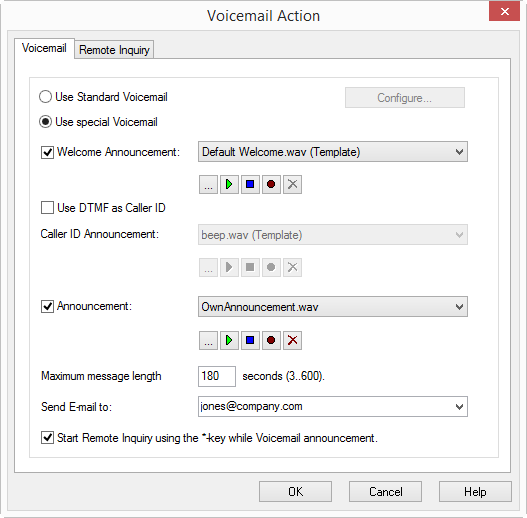The Voicemail action connects the caller to the Voicemail, which you have defined for this action:
If the caller’s number (Caller ID) is automatically transmitted, this will be saved together with the caller’s recorded Voicemail (message). You can then return the call using this number.
If no number is transmitted, then you can ask for the number in the following manner: The caller ID announcement is played, for example, with the announcement “please dial a telephone number with your phone where you can be reached. Conclude the telephone number with the hash button”. All incoming DTMF buttons entered by the caller up to the hash button (#) will be saved as the caller ID.
1 Define whether you would like to use your normal Standard voicemail or whether you would like to use a special voicemail for this action (e.g. with a different announcement).
If you would like to use the Standard voicemail, activate this option. It is still possible to change these values here. To do so, click on "Configure…".
2 To define the text of the welcome announcement, activate “Welcome announcement”.
You have several options:

From the dropdown list select a file.

Browse your hard drive by clicking on

.
Click on

, to listen to the selected file. Click on

to stop playing the file.

To record a new announcement, click on

: You will now be prompted to enter a file name. The “Start Recording” window will appear. Click on “Start” to begin recording the announcement. Stop recording by clicking on

.

To delete the selected file, click on

.
| The WAV files, which the administrator has made available to all users, have the extension “(Template)” in the file name. These templates cannot be deleted. |
3 Activate “Use DTMF as Caller ID” in order to ask for the caller’s number if the number was not transmitted. In this case, the caller can transmit his number (Caller ID) using DTMF tones.
You can define the announcement as you did for the “Welcome Announcement”.
4 Activate “Announcement” in order to set other announcements (this only makes sense if you have already asked for the caller ID in the previous step).
You can define the announcement as you did for the “Welcome Announcement”.
5 Enter how long the caller’s message should be recorded in the field “Maximum message length … seconds” (Timeout).
6 Indicate who the e-mail should be sent to in the field “Send E-mail to”.
7 Activate "Start Remote Inquiry using the *-key during Voicemail announcement" in order to listen to your voice mails or to remotely change your Call Forwarding Unconditional from another line.
8 Move to tab "Remote Inquiry".
9 Define whether you would like to use your normal Standard Remote Inquiry (with or without PIN) or whether you would like to use a special Remote Inquiry for this action (e.g. with a different PIN):

If you would like to use the Standard Remote Inquiry, activate this option. It is still possible to change the Standard Remote Inquiry here. To do so, click on "Configure…".
The "Standard Remote Inquiry" tab will open.

If you would like to configure a special Remote Inquiry, which is only valid for this action, activate the option "Use special Remote Inquiry".
10 Define the PIN (Personal Identification Number) to be used for identification and confirm this here.
11 In the field "Mail server" enter the name of the mail server to which your voice mails shall be sent.
12 In the field "User account" enter your user account for this mail server.
13 Enter your password on this mail server and confirm it.
14 Enter the name of the e-mail folder containing the new voice mails. Use "INBOX" as a synonym for "mail received"
| Enter a subdirectory here and please make sure that the correct name, e.g. “INBOX/Voicemails” is completely entered. (In this case use a ’/’ and not a ’\’). |
15 You can also define if SwyxServer shall use the security protocol SSL (Secure Socket Layer) during checking the voice mails at your mail server. Your mail server must support this protocol.
16 If you only want to listen to your voice mails, select the option "Use only E-mails from SwyxServer's originating voicemail address".
17 Click on "OK" to close the window.

 .
. , to listen to the selected file. Click on
, to listen to the selected file. Click on  to stop playing the file.
to stop playing the file. : You will now be prompted to enter a file name. The “Start Recording” window will appear. Click on “Start” to begin recording the announcement. Stop recording by clicking on
: You will now be prompted to enter a file name. The “Start Recording” window will appear. Click on “Start” to begin recording the announcement. Stop recording by clicking on  .
.